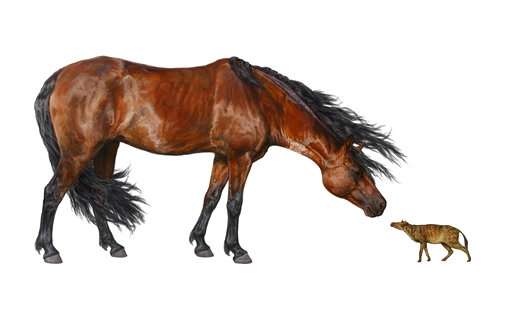A new research reveals that warm-blooded animals such as mammals may tend to get smaller as the Earth heats up. This does not include the people.
The scientists looked at fossilized teeth and jaw fragments of four animals that existed in the late Paleocene (59 million to 56 million years ago) through the early Eocene (56 million to 48 million years ago) epochs. This included Arenahippus pernix, which was an early ancestor of modern horses, and Diacodexis metsiacus — a rabbit-sized ancestor of pigs and deer.
Using the animals’ teeth size as a proxy for body size (a widely accepted practice), the researchers looked for evidence of dwarfing during the Eocene Thermal Maximum 2 (ETM-2) — a “hyperthermal” event roughly 53.7 million years ago, during which temperatures rose by about 3 degrees Celsius (5.4 degrees Fahrenheit). This was then compared with the well-documented evidence of dwarfing witnessed over a period of 10,000 years during the Paleocene-Eocene Thermal Maximum (PETM) hyperthermal event about 56 million years ago.
“We know that during the largest of these hyperthermals, known as the Paleocene-Eocene Thermal Maximum, or PETM, temperatures rose an estimated nine to 14 degrees Fahrenheit and some mammals shrank by 30 percent over time, so we wanted to see if this pattern repeated during other warming events,” study lead author Abigail D’Ambrosia, a doctoral student at the University of New Hampshire, said in a statement. “The hope is that it would help us learn more about the possible effects of today’s global warming.”
The pattern did repeat.
Fossil evidence revealed that during ETM-2, horses shrunk by 14 percent. Diacodexis, for which the fossil data was more limited, also shrunk by 15 percent during the hyperthermal event.
“During ETM2 temperatures only rose an estimated five degrees Fahrenheit and it was shorter only lasting 80,000 to 100,000 years, about half as long as the larger PETM. Since the temperature change was smaller, this suggests there may be a relationship between the magnitude of a global warming event and the degree of associated mammal dwarfism,” D’Ambrosia said.
The reason for this dwarfing is two-fold. For one, having a smaller body size increases the surface area to volume ratio, which, in turn, makes cooling off in a warmer planet more efficient. And two, the reduction in body size was a direct response to the climate change-induced lack of water and food.
“The carbon dioxide released during both hyperthermals has a similar footprint to today’s fossil fuels. … Developing a better understanding of the relationship between the change in mammalian body size during those events and today’s greenhouse gas-induced global warming may help to better predict possible future ecological changes in response to today’s climate changes,” the University of New Hampshire said in the statement.
Agencies/Canadajournal
 Canada Journal – News of the World Articles and videos to bring you the biggest Canadian news stories from across the country every day
Canada Journal – News of the World Articles and videos to bring you the biggest Canadian news stories from across the country every day



